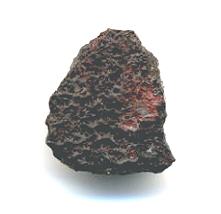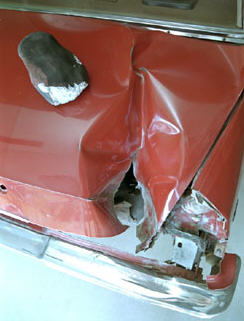H6

Fell October 9, 1992
41° 17′ N., 73° 55′ W. At 7:48 P.M. a greenish fireballA fireball is another term for a very bright meteor, generally brighter than magnitude -4, which is about the same magnitude of the planet Venus as seen in the morning or evening sky. A bolide is a special type of fireball which explodes in a bright terminal flash at its end, often with visible fragmentation. Click on Term to Read More brighter than the full moon appeared over Kentucky and traveled in a near-grazing trajectory of only 3.4° for more than 700 km in a north–northeasterly direction for at least 40 seconds, finally landing in Peekskill, New York. A sonic boom was heard as it fragmented into over 70 pieces, one of which impacted the trunk of a red Malibu coupe (see photo below) on 207 Wells St., the home of Michelle Knapp. When police arrived on the scene, they filed a report for criminal mischief by a very strong male. The smell of gas from the punctured gas tank finally prompted the fire department to investigate, at which time they found the meteoritic culprit. The stone was impounded by the police and subsequently fractured to see what was inside. This famous meteoriteWork in progress. A solid natural object reaching a planet’s surface from interplanetary space. Solid portion of a meteoroid that survives its fall to Earth, or some other body. Meteorites are classified as stony meteorites, iron meteorites, and stony-iron meteorites. These groups are further divided according to their mineralogy and Click on Term to Read More was eventually returned to the rightful owners.
The flight path of the Peekskill
meteoroidSmall rocky or metallic object in orbit around the Sun (or another star). was recorded on at least fourteen amateur videos, making this the first video obtained of a recovered meteorite. It was concluded from the videos, that there should be at least two, and possibly four or more, fragments which impacted the ground, but only the one 12.4 kg specimen has been recovered to date. Through analysis of these videos, a pre-atmospheric velocity of 14.72 km/s was calculated. The orbital parameters were worked out showing that it was only 41 days past its perihelion of 0.886
AUThe astronomical unit for length is described as the "mean" distance (average of aphelion and perihelion distances) between the Earth and the Sun. Though most references state the value for 1 AU to be approximately 150 million kilometers, the currently accepted precise value for the AU is 149,597,870.66 km. The Click on Term to Read More, with an
aphelionPoint farthest from the sun in a body's elliptical orbit. Click on Term to Read More distance of 2.1 AU. Only a few other meteorite falls have corresponding photographic, videotape, or
satelliteBody in orbit (such as a moon) around another larger body (such as a planet or star). Click on Term to Read More references which has enabled their orbits to be calculated; these are Lost City, Pribram, Innisfree, Morávka, Neuschwanstein, and Tagish Lake. Several other meteorite falls were observed well enough to calculate good orbital estimates, including Glanerbrug, Khmelevka, Dhajala, Paragould, Kunashak, Sikhote Alin, Vilna, Archie, Norton County, Nikolskoe, and Tilden, and today many camera networks are operating successfully around the globe determining meteoroid origins (see
Almahata Sitta).
A thermal history of the
H chondriteOrdinary chondrites with a high content of free Ni-Fe metal (15-19 vol. %) and attracted easily to a magnet. Their main minerals are olivine (Fa16-20) and the orthopyroxene bronzite (Fs14.5-18.5), earning them their older name of bronzite chondrites. Chondrules average ~0.3 mm in diameter. Comparison of the reflectance spectra of Click on Term to Read More parent bodyThe body from which a meteorite or meteoroid was derived prior to its ejection. Some parent bodies were destroyed early in the formation of our Solar System, while others like the asteroid 4-Vesta and Mars are still observable today. Click on Term to Read More was presented by Harrison and Grimm (2010) based on cooling rate data and closure times. They found that the object accreted over a short time period of 2.2 m.y. In an alternative viewpoint, Monnereau
et al. (2012) determined a more rapid
accretionAccumulation of smaller objects into progressively larger bodies in the solar nebula leading to the eventual formation of asteroids, planetesimals and planets. The earliest accretion of the smallest particles was due to Van der Waals and electromagnetic forces. Further accretion continued by relatively low-velocity collisions of smaller bodies in the Click on Term to Read More time period of 0.1–0.2 m.y. while
26Al was still extant. Moreover, Sokol
et al. (2007) concluded that accretion of the ~150 km H-chondrite parent body occurred relatively late after most radioactive
26Al had decayed, at least 2 m.y. after
CAISub-millimeter to centimeter-sized amorphous objects found typically in carbonaceous chondrites and ranging in color from white to greyish white and even light pink. CAIs have occasionally been found in ordinary chondrites, such as the L3.00 chondrite, NWA 8276 (Sara Russell, 2016). CAIs are also known as refractory inclusions since they Click on Term to Read More formation; it was probably heated by continuing impacts. It is generally considered that the asteroid eventually formed an insulated ‘onion-shell’ structure with a diameter of 150–260 km. The H-chondrite parent body was composed approximately (by volume) of 84%, 10%, and 6% of type 6, type 4/5, and type 3 material, respectively.
Amelin
et al. (2005) employed thermal models to calculate the progressive increase in petrologic types from the
coreIn the context of planetary formation, the core is the central region of a large differentiated asteroid, planet or moon and made up of denser materials than the surrounding mantle and crust. For example, the cores of the Earth, the terrestrial planets and differentiated asteroids are rich in metallic iron-nickel. Click on Term to Read More to the surface as follows: from the core outward to a distance of 44.9 km is type 6 material; between 44.9 km and 48.9 km is type 5 material; between 48.9 km and 56.9 km is type 4 material; and from 56.9 km to the surface at 92.5 km is type 3 material. Peak temperatures were determined to be 865–1000°C, 675–865°C, and <675°C for type 6, type 4/5, and type 3 material, respectively. The higher petrologic types were excavated at depth by impact, forming craters measuring tens of km wide and reaching depths of 5.6–11.2 km on their 200 km diameter model.
FissionBreaking apart of a body into smaller fragments. In nuclear physics, fission refers to splitting of a heavy atomic nucleus into two or more lighter nuclei with an associated release of energy. The mass of the nucleus before fission is greater than the combined masses of the resulting fragments; the Click on Term to Read More track thermochronometry indicates that type 7
chondritesChondrites are the most common meteorites accounting for ~84% of falls. Chondrites are comprised mostly of Fe- and Mg-bearing silicate minerals (found in both chondrules and fine grained matrix), reduced Fe/Ni metal (found in various states like large blebs, small grains and/or even chondrule rims), and various refractory inclusions (such Click on Term to Read More cooled more slowly at greater depths than did those of lower petrologic types (Trieloff
et al., 2003). Consequently, type 7 chondrites experienced a longer period of thermal metamorphism within this interior layer, and now they exhibit extensively recrystallized textures that are transitional to an
achondriteAn achondrite is a type of stony meteorite whose precursor was of chondritic origin and experienced metamorphic and igneous processes. They have a planetary or differentiated asteroidal origin where the chondritic parent body reached a sufficient size that through heating due to radioactive decay of 26Al (aluminum isotope) and gravitational Click on Term to Read More classification.
Importantly, a complex cooling history for the higher
petrologic typeMeasure of the degree of aqueous alteration (Types 1 and 2) and thermal metamorphism (Types 3-6) experienced by a chondritic meteorite. Type 3 chondrites are further subdivided into 3.0 through 3.9 subtypes. H chondrites (5/6) was suggested from thermometric studies conducted by Ganguly
et al. (2012). They reconciled data from calculations of two-pyroxene thermometers with the Ar–Ar, Pb–Pb, and Hf–W closure temperatures of select minerals to determine a cooling history consistent with very rapid cooling between ~800°C and 450°C, followed by a very slow cooling stage, and then another rapid cooling stage. By contrast, those H chondrites with lower petrologic types experienced a steady state of very rapid cooling. It was proposed that this scenario was more consistent with a collisional disruption and re-accretion of the parent body as opposed to a smoothly transitional ‘onion shell’ model.
Through analysis of radionuclides and cosmic ray tracks, a cosmic-ray
exposure ageTime interval that a meteoroid was an independent body in space. In other words, the time between when a meteoroid was broken off its parent body and its arrival on Earth as a meteorite - also known simply as the "exposure age." It can be estimated from the observed effects Click on Term to Read More of 32 m.y. was obtained, consistent with the earliest of three distinct impact events determined to have occurred at ~7.0, 22, and 33 m.y. ago. Peekskill is considered to have experienced a two-stage irradiation exposure. During the first stage, the sample was located 20–25 cm deep on a meteoroid having a radius of 40–60 cm. During the second stage, which lasted less than 200 k.y., the depth was >7 cm with a radius of 25–40 cm. A study was undertaken by V. Alexeev (2004) to determine the average atmospheric
ablationGradual removal of the successive surface layers of a material through various processes. • The gradual removal and loss of meteoritic material by heating and vaporization as the meteoroid experiences frictional melting during its passage through the atmosphere. The resulting plasma ablates the meteor and, in cases where a meteor Click on Term to Read More of 83 ordinary chondrites utilizing cosmic ray tracks. He calculated an average ablation of 78.4% (±3) for the entire
chondriteChondrites are the most common meteorites accounting for ~84% of falls. Chondrites are comprised mostly of Fe- and Mg-bearing silicate minerals (found in both chondrules and fine grained matrix), reduced Fe/Ni metal (found in various states like large blebs, small grains and/or even chondrule rims), and various refractory inclusions (such Click on Term to Read More study group, while Peekskill had a very high ablation of ~97%.
The Peekskill meteorite along with the famous red Malibu coupe, the latter having been purchased by meteorite collector A. Langheinrich (presently owned by D. Pitt), have been taken on tour through several countries including Germany, France, Japan, and Switzerland, as well as throughout the USA. The specimen of Peekskill shown above is a 0.72 g fragment with
fusion crustMelted exterior of a meteorite that forms when it passes through Earth’s atmosphere. Friction with the air will raise a meteorite’s surface temperature upwards of 4800 K (8180 °F) and will melt (ablate) the surface minerals and flow backwards over the surface as shown in the Lafayette meteorite photograph below. Click on Term to Read More exhibiting a faint smear of red paint transferred upon impact with Michelle Knapp’s car (see photo below). A video of the arrival of the Peekskill meteorite can be seen below.

Photo by Walt Radomsky. Courtesy of
R. A. Langheinrich Meteorites
Peekskill Video








